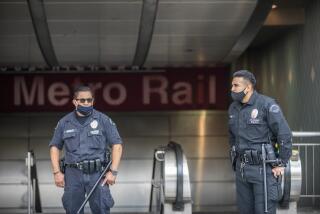To Meet L.A. Transit Needs, Get Agencies Out of Gridlock
Over the past two years I have been considering an agonizing reappraisal of the transportation future of Los Angeles. This reappraisal has been focused on two concerns: the needs of Los Angeles and the capacity of local transit agencies to meet the future mobility requirements of this great urban area. The experiences of the past two years--the posturing of transit agencies and their employees’ jockeying for position--have led me to the conclusion that the transportation future is bleak. Without a major change, we have no real hope of success.
The disputes between agencies and the myopia of many local leaders have been frustrating. But in my case, anxiety and frustration have been the parents of a vision--what we should do and how we should go about doing it.
There are five compelling reasons why the functions and staffs of various agencies must be merged and a new structure created to replace the transit planning and authority now spread among the Los Angeles City Council, the county Board of Supervisors, the Southern California Rapid Transit District and the county Transportation Commission.
First, the needs of Los Angeles are not being met. In fact, the transportation agencies are losing ground in their struggle to maintain mobility for people, goods and services while hundreds of millions of county sales-tax dollars lie idle in banks or government accounts.
Second, there is an enormous amount of duplication and overlap in the authority and jurisdiction of the governing bodies and professional staffs at the commission and the RTD. This has impeded and sometimes obstructed progress. The overlap results in everyone having his or her finger in everyone else’s project or program at every stage of its development. In short, it is hard to imagine how we could structure ourselves to be more inefficient.
As a result of the overlap and duplication, a third compelling reason for change emerges. Policy direction given to the staff is unclear and inconsistent. For example, the RTD and the commission both want to “contract out” services to provide for competition, better quality and less cost to the taxpayers. The commission has launched a private contracting effort, but the RTD is precluded by state law from doing so. Because the commission was set up by state law to be the RTD’s funding arm, its contracting-out effort likely will result in lawsuits filed by unions against the RTD and the commission. That is just one of the examples of the chaotic effects that stem from the overlapping legislation.
The ongoing staff disputes, duplications, jealousies and almost paranoid tendencies evidenced by staff members at the commission and the RTD are a source of concern to me. No matter who is right, or who is more right or more wrong than the other, the issue of continuing staff disputes is extremely unsettling to policy-makers and the general public. It is a fourth reason for consolidating the functions and restructuring the two organizations.
A fifth reason for consolidation is that the state legislation, regulations and federal requirements that the commission and the RTD must meet have left the public totally confused, and understandably so. Small wonder that the public, the press and others are clamoring for more accountability by elected public officials. No urban area in the country today has as confusing and overlapping a transportation structure as does Los Angeles.
Instead of going for legislation that would have streamlined the policy and management process in 1975, different legislation imposed the commission on the Los Angeles area in 1976. With its creation came further diffusion of authority and responsibility. This has created, in part, the chaotic conditions that we face today.
We must get to the hard issues of transportation. We must develop workable solutions to the problems that otherwise will strangle this urban area before it reaches its economic and commercial potential.
We need to start the legislative restructuring process in Sacramento this year. At the same time, we must create a commission of local elected public officials, business leaders, labor leaders, community leaders and others. We must get the best experts in the United States to help with the development of organizational structures and management systems so that Los Angeles does not reinvent the wheel. With the dedicated support from the governor and state Senate and Assembly leaders, legislation embodying the necessary changes could be passed and signed into law by September.
Unless we have a process, a plan for decision-making and a specific deadline for the completion of the task, Los Angeles will languish in its disorganization. We will all suffer from our lack of attention to the critical transportation issue. And we will have exhibited to ourselves and to the world that once again we let the future go by and lost a golden opportunity.
More to Read
Sign up for Essential California
The most important California stories and recommendations in your inbox every morning.
You may occasionally receive promotional content from the Los Angeles Times.










